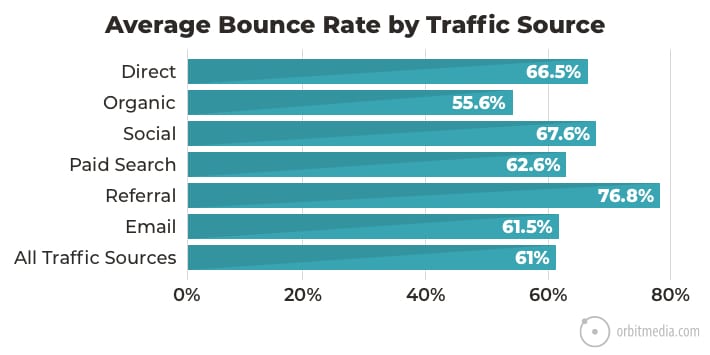by Kurt Scholle
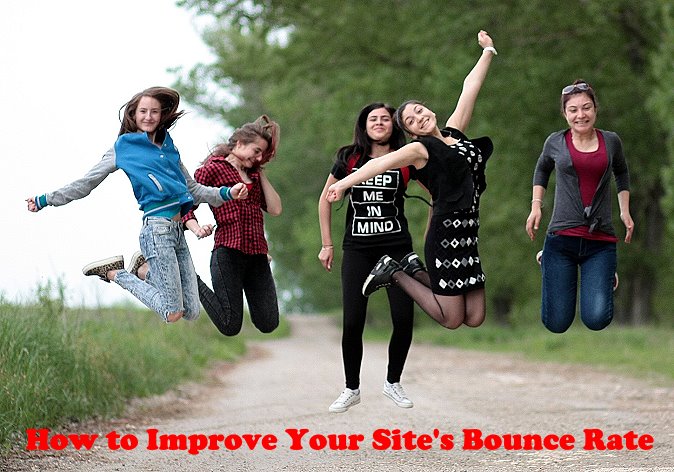
How to Reduce Bounce Rate on Your Website
First the definition: Bounce Rate, in Google Analytics, the ‘common definition’ of Bounce Rate is based on the percentage of people who land on any page of your website and never click on another page or return to the site.
That’s bad.
Usually, but not always, visitors need multiple exposures to your content, so the lower the Bounce Rate, the better.
Google says, “a high Bounce Rate generally indicates that the site entrance (landing) pages aren’t relevant to your visitors,”
Google Analytics will show you your entrance pages. Behavior -> Site Content -> Landing Pages
Personally, I see a lot of websites with Bounce Rates in the 80s, which means that 8 out of 10 or more visitors to a site, never click on anything or return.
We’ve also had clients with Bounce Rates below 50%
There are times when a high Bounce Rate (BR) is acceptable on specific pages. People sometimes search for directions to a local business and the Contact Page shows up. That’s all they need.
When you send traffic to a Squeeze Page or Opt-In offer. High BR is acceptable in these circumstances.
Reducing your Bounce Rate improves your Conversion Rate.
It’s also an important signal to Google. If site visitors stay on your site, it tells Google their suggestion of your site was good. If they land on a page and hit the back button, that signals to Google that your content was not well received.
In addition to viewing the entrance pages, you can view individual Bounce Rates for each page and post. Then by sorting from highest BR to lowest, you’ll identify the pages with the highest bounces and then revise them to keep visitors on your site. (We’ll show you how to lower your Bounce Rate below)

What is Average Bounce Rate?
Our friends at Orbit Media in Chicago surveyed 501 websites to find the average Bounce Rate across multiple industries.
The Average Bounce Rate is 61%
Half of all accounts in the survey had Bounce Rates of 50-70%. B2B websites had a slightly higher BR than B2C, 61.9% to 60.1%, according to Orbit’s research.
A number of things affect Bounce Rate, among them Traffic Sources. Referral traffic has highest Average Bounce Rate at 76.8% Organic search is lowest at 55.6%
 Bounce Rates by Traffic Source
Bounce Rates by Traffic Source
You can see your overall Bounce Rate by going to Behavior -> Overview. It’s a composite of all of your pages and blog posts from multiple traffic sources.
Drill down by clicking Acquisition -> All Traffic -> Channels. Notice the different Bounce Rates for each traffic source. Different traffic sources usually represent different intent, depending on where they are in the buying cycle and their relationship with your brand.
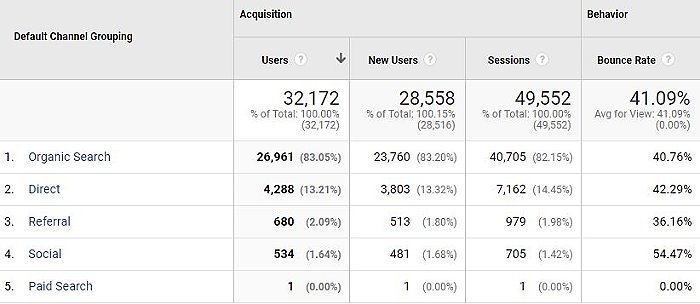
With our client, the traffic source with the highest BR is Social at 54.47% They get 83% of their total traffic from Organic Search, which has a BR of just 40.76%, which is better than the Average Bounce Rate for Organic Traffic in the Orbit study.
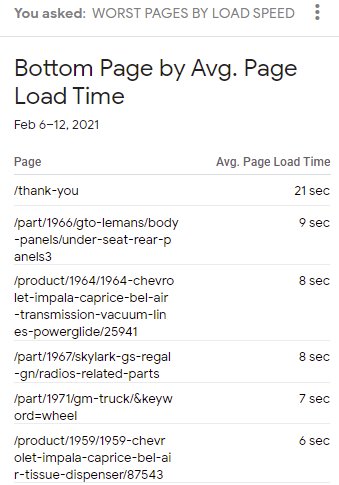 Your mileage may vary.
Your mileage may vary.
While you’re on the page, you can also see the average number of Pages/Session and Avg. Session Duration. You will sometimes see a range of results for different KPIs.
There is a report in Google Analytics that will list “WORST PAGES BY LOAD SPEED. You may want to run the report and see what you can fix.
Bounce Rate, Pages Per Session and Duration are all loyalty metrics. They will all give you different perspectives, and you will usually see some similarities. As Bounce Rate goes down, you usually see Pages/Session and Duration grow.
You can drill down to specific pages under Behavior -> Site Content -> All Pages. You can sort from highest BR to lowest to find content that is not resonating with your visitors.
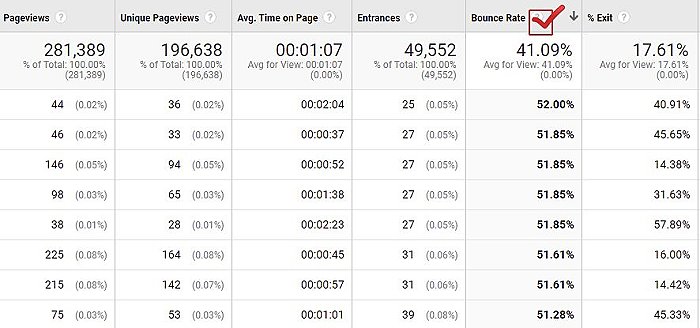
Search Engines and Bounce Rate
Different search engine traffic has different Bounce Rates. Our client’s BR for Google is 43.05% For Bing, it’s 23.45% Facebook referral traffic bounces 67.34% of the time.
For you, the numbers might be totally different. Go to Acquisition -> All Traffic -> Source Medium and see for yourself.
How do you lower your Bounce Rate? 19 tips to get your content read and your visitors converted. Share on XHow do you lower your Bounce Rate?
Reducing your Bounce Rate improves your Conversion Rate, so here are some ideas to help you do that.
- Headlines can be key. Try and write headlines with a high Click Thru Rate, then use them in your content to entice people to click around. Headlines work when they appeal to people’s emotions
You can test headlines for free using headline analyzers from CoSchedule or The Advanced Marketing Institute. Use these headline analyzers and you will become a better writer.
- Formatting content. Make your pages easy to read. Long paragraphs are a turnoff. People tend to scan content before they commit to reading it. They want to confirm that it’s the solution they were looking for.
I talk more about ‘chunking’ content in a previous post How To Chunk Website Content, but the technique to make your content more readable relies on Headers and sub-headlines, short paragraphs, bullet lists, bolding and italics and using multiple images or videos.
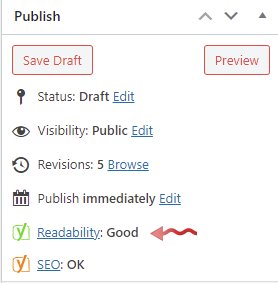 Use related keywords in sub-headlines. It helps confirm your content is what they’re looking for as they scan your article first, which will keep them on the page. It will also help attract visitors via Search Engine Optimization.
Use related keywords in sub-headlines. It helps confirm your content is what they’re looking for as they scan your article first, which will keep them on the page. It will also help attract visitors via Search Engine Optimization.
H-tags and bolded text are signals to the search engines about what the content is about.
There are plugins, including Yoast, that will score your page’s readability. You can also use an online tool, like Readable, to calculate readability of individual URLs or by direct input.
- Calls To Action. Tell visitors what to do next with effective, usually graphical Calls To Action. All pages have a ‘job.’ (If they don’t, you should ask yourself why it’s even on your site.)
For example, one of the most viewed pages on a site is the Home page, which I think should confirm what the site is about to first-time visitors and get them moving to the most appropriate section.
That one click drops your Bounce Rate and improves your chances of doing business with them
If you blog about food, you might silo your content by entrees, appetizers, desserts and cocktails. Or you might organize it by recipes, cookware and books. Think of Home pages as the site’s Table of Contents.
Blog posts may serve as pre-framing articles. The ‘job’ of the blog post is to get the visitor to buy your product or service, subscribe to your newsletter, call you on the phone or come to your location.
Making CTAs VERY apparent are critical to a page’s success. It’s OK to have the CTA show more than once. It could be graphical (preferred) or a text link. Or both.
I also recommend split-testing the text on any buttons. “Get it now!” might be more effective than “Submit.” The color and size of the button will influence conversions and therefore, Bounce Rate.
Effective Calls To Action help keep people on your site and clicking to other pages.
Free trial offers work well.
- More Content That Converts. Think like a copywriter with these copywriting tips. Successful copywriters use writing patterns or formats to guide their writing. Storytelling is VERY effective. People identify with stories.
Study the masters, like Gary Halbert or Dan Kennedy. Halbert was considered the “Greatest Copywriter Who Ever Lived.” He published a number of books on the subject, including “The Halbert Copywriting Method.”
Dan Kennedy’s “The Ultimate Sales Letter” is one of my favorite books of all time.
Follow Ann Handley on Twitter. Handley always recommends “make the customer the hero of the story.”
Karon Thackston highlights the importance of knowing your audience. “If you don’t have a good handle on who you are trying to communicate with through your copy, your chances of success will dwindle.” You can pick up her free target audience worksheet and video here.
Brian Clark at Copyblogger.com tells great marketing stories and is an excellent blogger.
- Write Better Meta Descriptions for Search Users. Overall Bounce Rate will drop if your content best meets the needs of the people reading it. So, to attract the right visitors, give them an attractive meta description, which shows up on the SERPs.
Meta descriptions should be 155 characters or less – Most search engines show a maximum of 160. Include a benefit. What will they get or become if they read your content?
- Improve Site Design & UX. Poorly designed or organized sites build Bounce Rate, especially if they look like they were designed in 2004. Good User Experience helps guide visitors thru your site and to completion of your overall goals.
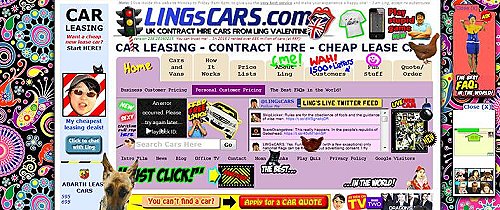
Make your site easy to understand and search.
- Offer a Great Navigation Experience. Similar to (or part of) improving the User Experience, your site’s navigation will impact Bounce Rates, simply by making it easy to drill down. Most visitors will only go down 3 levels of a NAV bar.
Also try and make your NAV bar viewable at all times.
- Crosslink Related Content. You don’t lower your site’s Bounce Rate just because you want a lower BR. You should try and lower your BR for strategic purposes.
The more people who consume your content, the more opportunities you will have to convert them. The more content they read or watch, the more they will know, like and trust you.
For better conversion, you could simply write longer articles, perhaps 5,000 words or more. Or you could break all that up into separate pieces that are related, but optimized for different keywords. There is an SEO benefit to that, attracting more qualified leads using semantic keywords. You are also creating more landing or entrance pages.
How to Crosslink Content on a Web Page
You can crosslink any text on your site to any URL. There are plugins that will list related articles at the bottom of the page.
Another way to crosslink content on a web page is by having a Table of Contents at the top of the page of at least one post and hyperlink the “chapters” or related content together.
And finally, use Categories. Some SEOs recommend that websites have 5-8 or even 12 categories. These are called SILOs and are treated like standalone websites. Show your site’s categories in your sidebar and you will get visitors to click on them. Once they do, they are shown a list of all posts in the category. (For more on SILOing content, click here.
How to Improve Bounce Rate
- Remove the Dates of your blog, especially if you’re publishing evergreen content. Some people will look at an old date and reject even skimming the content. Turning the dates on or off vary, depending on the WordPress theme being used. Poke around a bit to find it or Google something like “turn post dates off in “whatever” theme.” How to Find the Dates of Blog Posts.
- Avoid Popups. Popups help build email lists. They’re annoying but effective. You may want to limit or eliminate popups on certain pages. You might delay how quickly they fire. (I personally leave pages when a popup fires within a few seconds of landing there.)
- Avoid Social Widgets. Social widgets that show the number of shares or tweets, especially if you don’t have any, can also discourage readers.
- Increase Traffic From Low Bounce Rate Sources. Better traffic from better prospects. Find out your numbers in Google Analytics: Acquisition -> All Traffic
- Make sure your site is Mobile-Friendly. Not only will you make it a better user experience for people consuming your content on mobile devices, Google is emphasizing that sites be responsive (mobile-friendly), and, in fact, is indexing websites using their Mobile-First algorithm. Use the Google Mobile-Friendly Test.
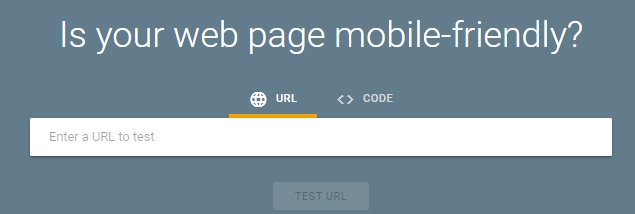
18. Speed Up Your Website. Visitors will bail out on slow-loading websites. Research has shown that the probability of bounce is 32% on pages with load speeds of just 1-3 seconds. At 1-5 seconds, the probability of bounce increases 90%
I wrote more about speeding up your WordPress site and include links to applications that will test your website speed and give you recommendations to speed up page loading: How to Speed Up Your WordPress Site.
Some common ways to speed page loading are to reduce the size of image files and to reduce the number of plugins you’re using.
19. Retargeting. Most of what we’ve talked about is designed to keep people on your site and clicking around, not just to lower the Bounce Rate, but to convert them to clients.
You will also lower your website’s Bounce Rate by getting them to return to your site. You can re-engage them on social media, or send them an email if they are on your list.
You can also retarget them with a retargeting (or remarketing) pixel, which cookies them and allows you to target them as a ‘custom audience’ with Google or Facebook ads.
Bottom Line
The more you attract qualified leads to your website and keep them reading your content and coming back for more, the better your relationship with them. The better your relationship, the more they will know, like and trust you. Put these tips to good use!


